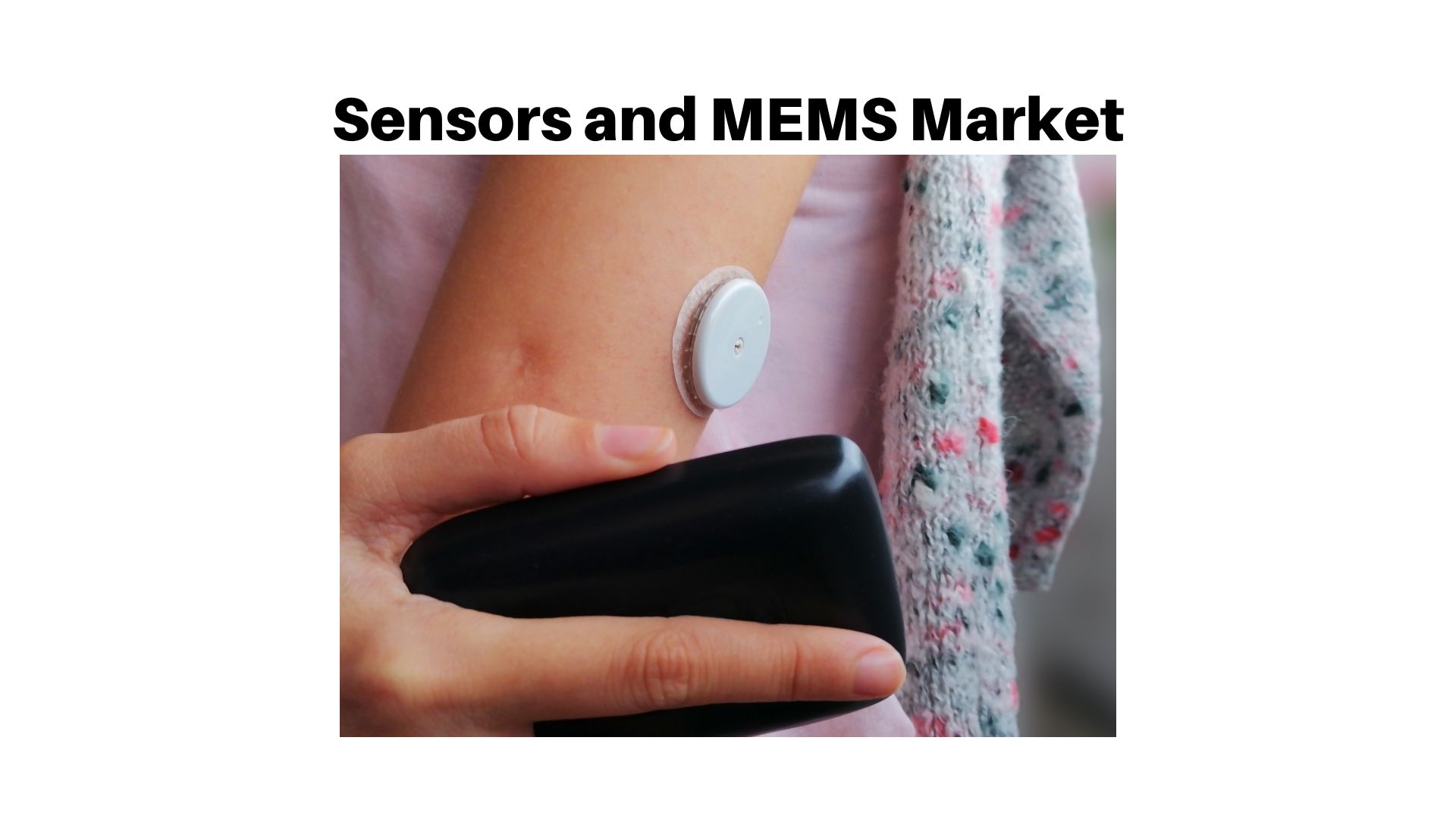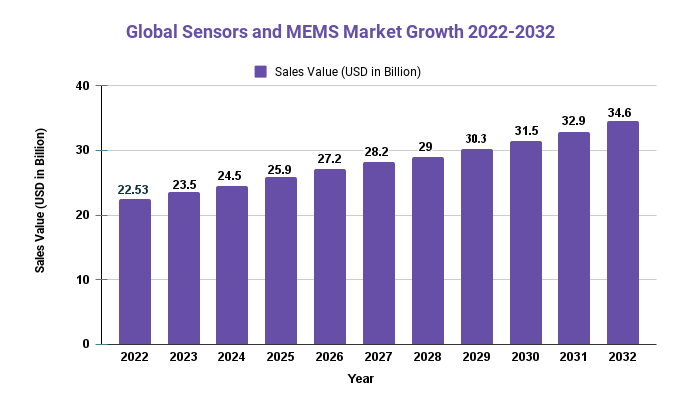Sensors and MEMS Market Size is Projected to reach USD 34.6 Billion by 2032

Page Contents
Published Via 11Press: The Sensors and MEMS Market size are expected to be worth around USD 34.6 Bn by 2032 from USD 22.53 Bn in 2022, growing at a CAGR of 4.5% during the forecast period from 2022 to 2032.
The sensors and MEMS market is a growing industry that plays an essential role in the development of various technological devices. The market revolves around the manufacture and sale of sensors, which are used to detect changes in their environment, and MEMS (micro-electromechanical systems), which are miniature mechanical devices combined with electronic circuits. Both technologies have seen tremendous growth due to increasing demand for smart devices across different industries.
In recent years, there has been a significant increase in the use of sensor technology across various sectors such as healthcare, automotive, aerospace, and defense. The healthcare industry uses sensors for monitoring vital signs such as blood pressure and heart rate. Additionally, automotive manufacturers integrate sensors to enhance safety features like collision avoidance systems. In contrast, the aerospace industry employs sensors for navigation applications like altitude sensing during takeoff or landing.
Want to Access the Statistical Data and Graphs, Key Player's Strategies | Request a sample report

Key Takeaways
- The global sensors market is expected to reach $34.6 billion by 2032, expanding at a compound annual growth rate (CAGR) of 4.5% from 2022-2032.
- MEMS technology is a major factor driving growth in the sensors market, with applications across industries such as automotive, healthcare, consumer electronics, and aerospace.
- The automotive industry is the largest market for MEMS sensors, driven by an increasing need for safety and automation features in vehicles.
- The healthcare industry is another key user of MEMS sensors, with applications in medical devices like blood pressure monitors, insulin pumps, and implantable gadgets.
- Consumer electronics is another prominent market for MEMS sensors, with applications in smartphones, wearables, and gaming devices.
- The demand for environmental sensors is on the rise, driven by requirements in air quality monitoring, pollution control, and smart home applications.
- The Asia-Pacific region is the leading market for sensors and MEMS, with China and Japan contributing significantly to growth.
- Key players in the sensors and MEMS market include Robert Bosch, Honeywell International, HP, STMicroelectronics, Texas Instruments, and InvenSense.
- Emerging technologies such as the Internet of Things (IoT), artificial intelligence (AI), and 5G connectivity are expected to fuel further expansion in the sensors and MEMS market.
However, obstacles such as high development costs, supply chain disruptions, and regulatory obstacles could hinder market expansion.
Regional Analysis
- The North American market for sensors and MEMS is driven by major technology companies with a strong emphasis on innovation. Key players in this space include Analog Devices, Texas Instruments, and Honeywell International. North American industries such as automotive and healthcare are major buyers of sensors and MEMS from this region.
- The European market for sensors and MEMS is highly-competitive, with major players such as Bosch and STMicroelectronics operating within it. The automotive industry is a key demand driver, driven by electric and autonomous vehicles; additionally, the aerospace and defense sectors are major users of sensors and MEMS in this region.
- The Asia-Pacific region is the leading market for sensors and MEMS, thanks to major manufacturing hubs in China, Japan, and South Korea. With an increasing middle class and increasing consumer electronics demand in this region, sensors and MEMS are in high demand there too. Furthermore, automotive industry players are seeing increasing demand for safety and automation features on vehicles as well.
- The Latin American market for sensors and MEMS is growing, although still small compared to other regions. With an expanding industrial base and rising infrastructure investment, there is a surge in demand for these components in applications such as smart cities or environmental monitoring systems.
- The Middle East and African market for sensors and MEMS are experiencing strong growth, due to investment in infrastructure as well as increasing consumer electronics demand. Furthermore, the region's growing automotive industry also contributes to this expansion in demand for sensors and MEMS.
Drivers
- Growing Demand From Automotive Industry: The automotive industry is a major market for sensors and MEMS, driven by rising demands for safety and automation features in vehicles. These technologies include advanced driver assistance systems (ADAS), vehicle-to-vehicle (V2V) communication, as well as autonomous driving. MEMS sensors are utilized in tire pressure monitoring systems, airbag deployment systems, and engine control systems among other applications.
- MEMS Sensors Are Becoming More Commonplace: MEMS sensors are increasingly found in consumer electronics products such as smartphones, wearables, and gaming consoles. With the growing demand for these items particularly in emerging economies comes an increased opportunity for MEMS sensor manufacturers.
- Rising Demand for Healthcare Devices: The healthcare industry is a major user of MEMS sensors, with applications in medical devices like blood pressure monitors, insulin pumps, and implantable gadgets. An aging population and rising chronic disease prevalence rates driving this demand for these products.
- The emergence of the Internet of Things (IoT) and Smart Technologies: As these devices become more prevalent, demand for sensors and MEMS is expected to soar, as these systems require various sensors for data collection and transmission. Smart homes, cities, and factories are some major applications where sensors and MEMS are utilized in these technologies.
- Environmental Monitoring: With growing concerns about environmental pollution and climate change, demand for environmental sensors has grown. These instruments monitor air and water quality, detect pollutants, and keep an eye on weather patterns.
- Technological Advances: Recent advances in MEMS technology are allowing the creation of smaller, more accurate, and reliable sensors that are driving demand from various industries. This includes microfluidic sensors that could be utilized for medical diagnostics or environmental monitoring applications.
- Overall, the sensors and MEMS market is being driven by a number of factors with significant growth prospects across various end-use industries.
Restraints
- High development and manufacturing costs: MEMS technology necessitate highly specialized, sophisticated manufacturing processes that can be expensive. This makes it difficult for smaller companies to break into the market and restricts its application in certain applications.
- Integration Challenges: Integrating MEMS sensors with other systems and components can be a complex undertaking, particularly in highly integrated applications like smartphones or wearables. This poses a barrier to MEMS technology adoption in certain markets.
- Limited Sensitivity and Accuracy: While MEMS sensors boast higher sensitivity and accuracy compared to traditional sensors, they may not be sensitive enough for certain applications like medical diagnostics or environmental monitoring.
- Absence of Standardization: In the MEMS sensor and device industry, lack of standardization makes it difficult to compare and evaluate different products, potentially hindering their adoption in certain industries.
- Limited Supply of Raw Materials: MEMS sensors requires specialized raw materials such as silicon wafers, which may not always be readily available or subject to price fluctuations.
- Competition: The sensors and MEMS market are highly competitive, with numerous established players and new entrants competing for market share. This makes it difficult for companies to differentiate themselves and can result in price pressures.
- Overall, while the sensors and MEMS market have considerable growth potential, there are a variety of challenges and obstacles which could restrict its adoption or development in certain markets.
Browse the summary of the report and Complete the Table of Contents (TOC)
Opportunities
- Expansion in Emerging Markets: Emerging markets, particularly Asia-Pacific and Latin America, offer significant expansion prospects for the sensors and MEMS market. The growing demand for consumer electronics, automotive, and healthcare devices in these regions is fueling demand for MEMS sensors.
- Advancements in sensor technology: Recent advancements in sensor technology, such as microfluidic sensors and nanosensors, offer MEMS sensors new opportunities in medical diagnostics, environmental monitoring, and other applications.
- Adoption of Industry 4.0 and Smart Manufacturing: As the industry transitions towards Industry 4.0 and smart manufacturing, demand for sensors and MEMS in industrial automation and control systems is on the rise. MEMS sensors can be utilized in smart factories to monitor processes, resulting in greater efficiency and productivity gains.
- Growing Demand for Wearable Devices: Wearable devices, such as smartwatches and fitness trackers, are becoming a major market for MEMS sensors. The growing popularity of these items is propelling growth in the sensors and MEMS industries.
- The adoption of autonomous vehicles is driving demand for sensors and MEMS in automotive applications, particularly LiDAR sensors used in autonomous driving systems.
- Growing Demand for Environmental Monitoring: With growing concerns about environmental pollution and climate change, there is an increasing demand for environmental sensors. This presents MEMS sensors with potential applications in areas such as air and water quality monitoring, along with weather forecasting.
- Overall, the sensors and MEMS market offer numerous opportunities for growth and expansion due to technological advancements and rising demand from various end-use industries.
Challenges
- Complexity in Design and Manufacturing: MEMS technology necessitates highly specialized design and manufacturing processes that can be time-consuming and expensive. This makes it challenging for smaller companies to break into the market, restricting its application in certain circumstances.
- Limited Accuracy and Sensitivity: While MEMS sensors boast higher sensitivity and accuracy compared to traditional sensors, they may not be sensitive enough for certain applications such as medical diagnostics or environmental monitoring.
- Integration Challenges: Integrating MEMS sensors with other systems and components can be a complex undertaking, particularly in highly integrated applications such as smartphones and wearables. This could pose an obstacle to the widespread adoption of MEMS technology in certain markets.
- Lack of Standardization, and Lacking standardization in MEMS sensors and devices make it difficult to compare and evaluate different products, potentially restricting their adoption in certain industries.
- Limited Supply of Raw Materials: MEMS sensors requires specialized raw materials, such as silicon wafers, which may not always be readily available and price fluctuations can occur. Competition The sensors and MEMS market is highly competitive, with numerous established players and new entrants competing for market share. This makes it difficult for companies to distinguish themselves and may lead to price pressures.
- Security and Privacy Concerns: With the increasing use of sensors and MEMS in connected devices and systems, security and privacy have become heightened concerns, particularly in applications such as healthcare and smart homes.
- Overall, the sensors and MEMS market face several obstacles that may hinder its adoption and growth in certain markets. To overcome these difficulties, continued technological innovation, standardization, and collaboration among industry players will be necessary.
Report Scope
| Report Attribute | Details |
| The market size value in 2022 | USD 22.53 Bn |
| Revenue forecast by 2032 | USD 34.6 Bn |
| Growth Rate | CAGR Of 4.5% |
| Regions Covered | North America, Europe, Asia Pacific, Latin America, and Middle East & Africa, and the Rest of the World |
| Historical Years | 2017-2022 |
| Base Year | 2022 |
| Estimated Year | 2023 |
| Short-Term Projection Year | 2028 |
| Long-Term Projected Year | 2032 |
Key Market Segments
Type
- Microfluidic MEMS
- Pressure Sensor
- Quarterly Pressure Sensors
- Others
Application
- Automotive
- Consumer Electronics
- Industrial
- Healthcare
- Others
Key Market Players included in the report:
- Robert Bosch
- Honeywell International
- HP
- STMicroelectronics
- Texas Instruments
- InvenSense
Frequently Asked Questions
What is the market study period?
The Sensors and MEMS Market are studied from 2017 – 2032.
What is the growth rate for the Sensors and MEMS Market?
The Sensors and MEMS Market is growing at a CAGR of 4.5%
Who are the major players in the Sensors and MEMS Market?
Robert Bosch, Honeywell International, HP, STMicroelectronics, Texas Instruments, InvenSense
The team behind market.us, marketresearch.biz, market.biz and more. Our purpose is to keep our customers ahead of the game with regard to the markets. They may fluctuate up or down, but we will help you to stay ahead of the curve in these market fluctuations. Our consistent growth and ability to deliver in-depth analyses and market insight has engaged genuine market players. They have faith in us to offer the data and information they require to make balanced and decisive marketing decisions.



